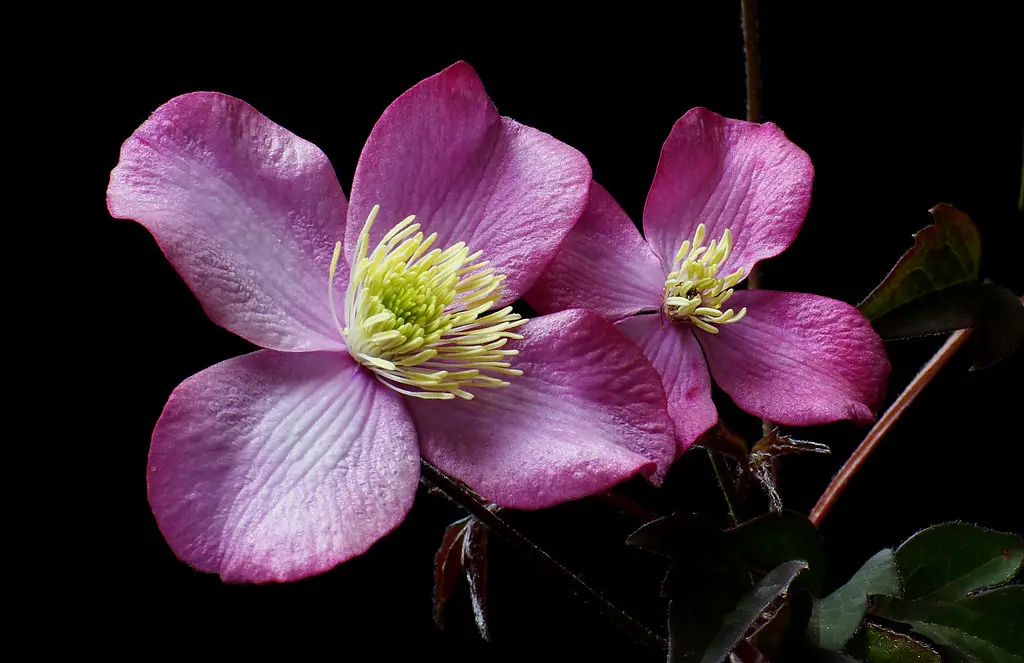Clematis, a stunning climber, is known for its luxurious and vibrant flowers. The genus comprises over 300 species and many hybrids, offering an endless variety of colors, forms, and blooming seasons. From the bold, large-flowered hybrids to the delicate, small-flowered species, clematis adds visual interest and an aesthetic appeal that few other climbers can match.
They often climb trellises, fences, or other plants, weaving their way through the landscape and creating a living art. When in full bloom, they can transform a simple garden arch into a breathtaking floral display. They’re favored not only for their visual beauty but also for their adaptability and resilience.
Clematis can be grown in different climates and comes in both evergreen and deciduous types. They are popular in cottage gardens and are often combined with other climbers or roses for a layered effect. With proper care, clematis can be a long-lived, dependable star in any garden setting.
| Common Names | Clematis |
|---|---|
| Botanical Name | Clematis spp. |
| Family | Ranunculaceae |
| Plant Type | Perennial vine |
| Mature Size | 3 to 20 feet tall, depending on species and variety |
| Sun Exposure | Full sun to part shade |
| Soil Type | Well-drained, humus-rich soil |
| Hardiness Zones | 4 to 9, depending on species and variety |
| Native Area | Worldwide |
Clematis Care
Clematis is a versatile vine that requires some attention to planting and early care but rewards the gardener with robust growth and abundant flowers. It prefers a sunny location with well-drained soil rich in organic matter.
Though it might seem daunting, pruning clematis helps to ensure vigorous growth and flowering. Understanding the specific pruning needs of your clematis (grouped into three categories based on flowering time) will guide you in keeping your plant healthy and thriving.
Light Requirement for Clematis
Clematis thrives best in full sun to part shade. While the roots prefer cool, shaded conditions, the vines and flowers need several hours of sunlight for optimal growth and blooming.
Soil Requirements for Clematis
Clematis prefers well-drained soil that is rich in organic matter. Adding compost or well-rotted manure can improve soil fertility. Avoid waterlogged conditions, as this can lead to root rot.
Water Requirements for Clematis
Clematis needs regular watering, especially during dry periods. A deep soaking once a week is usually sufficient. Mulching helps in retaining soil moisture and keeping the roots cool.
Temperature and Humidity
Clematis is adaptable to various temperature ranges, depending on the species and variety. While generally resistant to humidity, proper spacing and pruning can prevent potential fungal diseases.
Fertilizer
A balanced fertilizer applied in early spring can promote healthy growth. A low-nitrogen formulation is preferred, as high nitrogen levels may lead to excessive leaf growth at the expense of blooms.
Pruning Clematis
Pruning clematis is essential for encouraging new growth and blooms. The specific pruning method depends on the flowering time and variety, so understanding your clematis group is vital.
Propagating Clematis
Clematis can be propagated through stem cuttings, layering, or division. The best time for propagation is spring or early summer, depending on the method and variety.
How To Grow Clematis From Seed
Growing clematis from seed is a lengthy process but can be rewarding. Fresh seeds can be sown in the fall, while stored seeds may require cold stratification before planting.
Common Pests & Plant Diseases
Aphids
Aphids can be controlled with insecticidal soap or neem oil.
Clematis Wilt
This fungal disease can be avoided by proper planting and pruning techniques.
Common Problems With Clematis
Failure to Bloom
This might be due to improper pruning or inadequate sunlight. Adjusting these factors can lead to successful blooming.
Yellowing Leaves
Often a sign of over-watering or poor drainage. Check the soil and adjust watering habits accordingly.
Pro Tips
- Plant the crown 3 to 4 inches below the soil surface to encourage new shoots.
- Support with a trellis or similar structure to allow the vine to climb.
- Combine with other climbers like roses for a stunning display.




